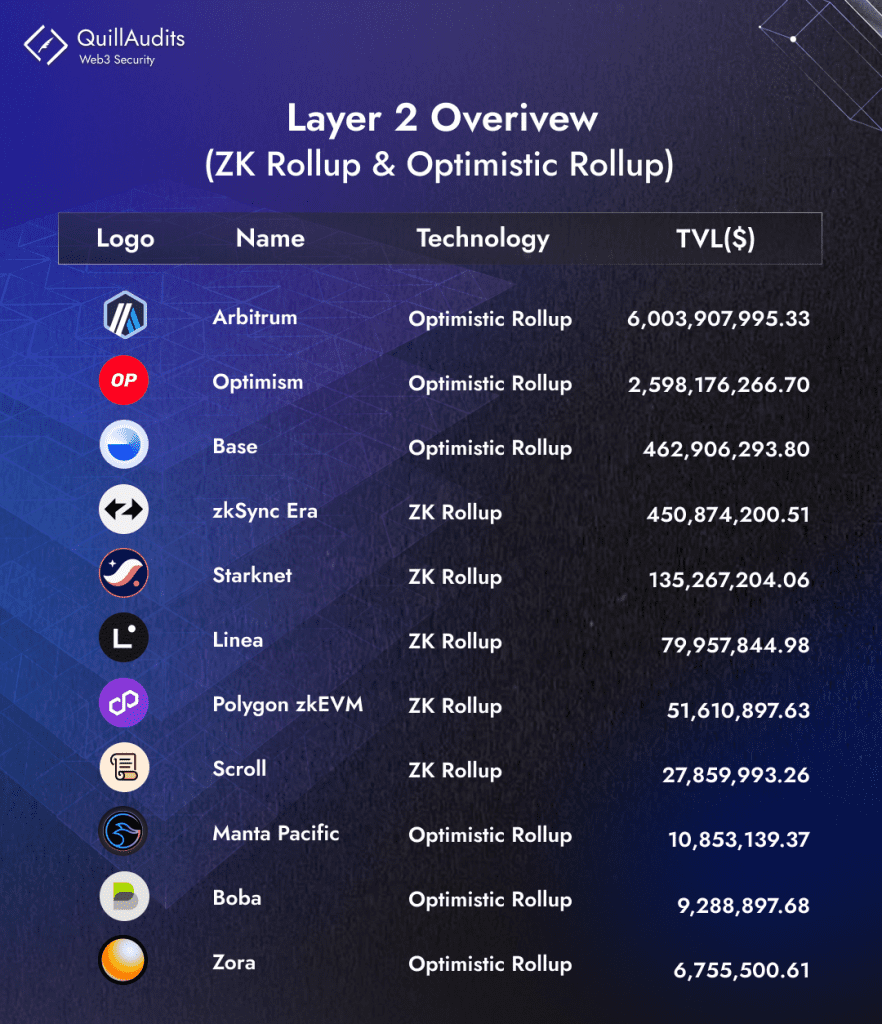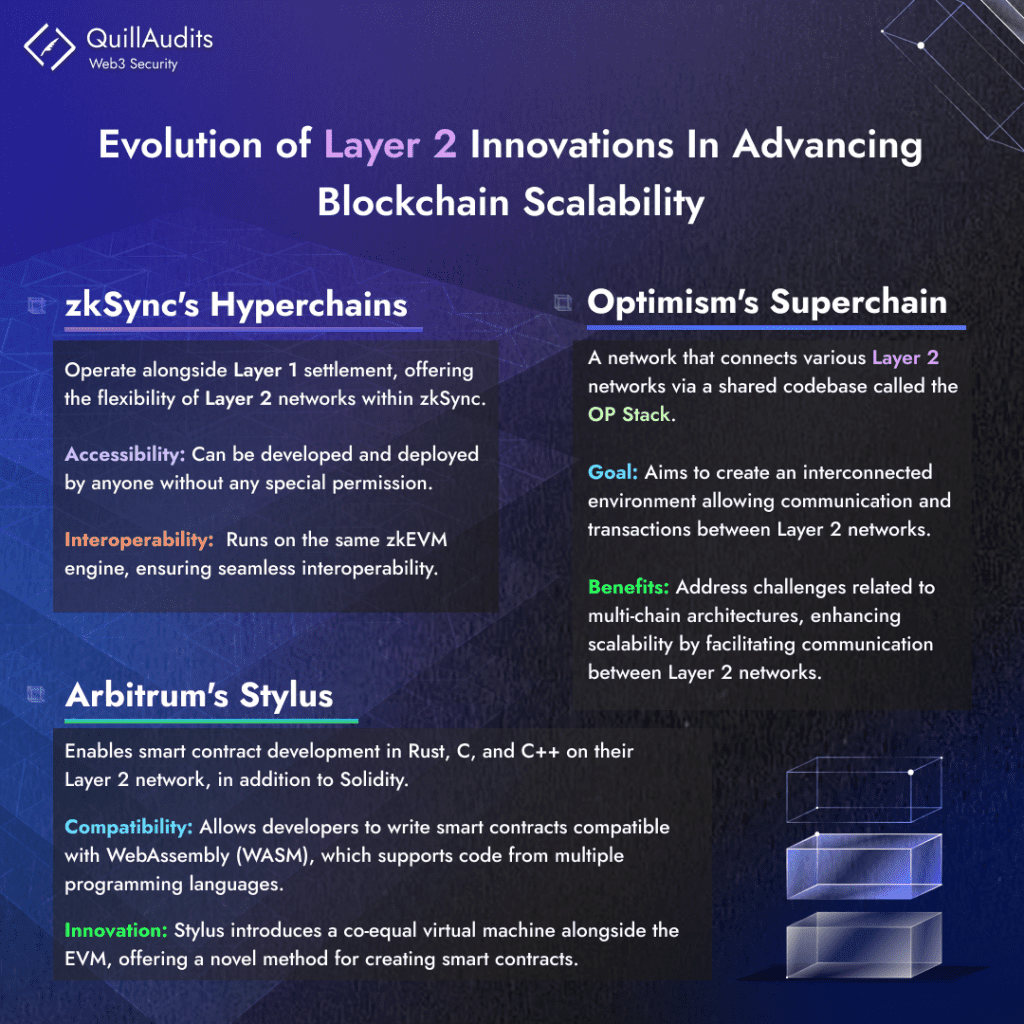Ethereum stands out among smart contract blockchains, largely due to the substantial impact of Layer 2 solutions on its rise. These solutions, such as Optimism and Arbitrum, boast a larger Total Value Locked (TVL) on Ethereum than major Layer 1 blockchains like Solana.
Layer 2 solutions are designed to enhance Ethereum’s capabilities, aiming to make the network faster, more scalable, and cheaper for users when making transactions.
Now that we’ve touched on the importance of Layer 2, let’s delve into the article to explore the broader Layer 2 ecosystem and the different types of Layer 2 solutions available.
Diving into the world of Layer 2:
Why does it matter?
Blockchain is much praised for its desirable qualities of Decentralization, Security and Scalability. But trying to have all three at once? Super hard. Compromising on any of it means slower transactions, higher costs, and slow processing times—layer 2 solutions step in to tackle these challenges using an innovative approach.
How does Layer 2 solve the blockchain trilemma?
Layer 2 solutions work their magic by moving transactions to different Layers. This way, they handle more transactions way faster and cost-effectively. Think of it like bundling a bunch of off-chain transactions into one big on-chain transaction. This makes fees much lower, making Ethereum user-friendly for lots more people.
That’s why big players like Arbitrum and Polygon are all in for making crypto transactions easier and cheaper and opening the door to more things we can do on blockchains.
How have Layer 2 solutions improved blockchain usage?
The adoption of Layer 2 scaling solutions is evident through the increasing number of daily active addresses, surpassing several Layer 1 blockchain networks. Let’s explore the impact these solutions have had.
- Arbitrum leads the way in developing Layer 2 solutions, boasting a thriving ecosystem of 331 decentralized applications.
- Total Value Locked (TVL) showcases user trust, emphasizing a strong preference for Layer 2 solutions. Both Arbitrum and Optimism exceed the TVL of competing Layer 1 chains like Solana and Avalanche, reflecting user confidence.
- In the realm of notable Layer 2 projects, Optimism and Arbitrum stand out with nearly $1 billion market caps and successfully launched tokens.
- Starknet shows exceptional developer engagement, while zkSync leads in daily addresses and total transactions among the listed Layer 2 solutions.
- Optimism’s growth, attributed partly to its Optimism Superchain vision and BASE’s involvement, has made it the largest Layer 2 by market cap. (More on this Superchain below).
Now that we’ve covered the prominence of Layer 2 solutions, let’s delve into the various types of Layer 2.
What are the different types of Layer 2s?
Layer 2 solutions can be broadly categorized as,
- Rollups
- State Channels
- Plasma
- Side Chains
Rollups
Layer 2 rollups are scaling solutions operating off the Ethereum blockchain but record transaction data on the main chain (Layer 1), securing transactions with Layer 1’s security measures.
Here is a list of some properties of rollups,
- By executing transactions, it reduces gas fees.
- Transaction data resides on Layer 1, thereby ensuring security.
- A rollup smart contract on Layer 1 oversees and enforces transaction execution on Layer 2 using stored Layer 1 data.
- Users stake a bond in the rollup smart contract, incentivizing accurate transaction verification.
There are two types of Rollups:
- Optimistic Rollups: Operate parallel to Ethereum’s mainnet on Layer 2 and don’t compute transactions by default. After completing transactions, it submits new states to the Ethereum mainnet, reducing gas fees.
Advantages: Low gas fees, increased throughput, smart contract capabilities, Ethereum Mainnet’s security.
Applications: Arbitrum, Boba, Cartesi, Fuel Network, Optimism
- Zero-Knowledge Rollups (ZK Rollups): Bundles numerous transactions off Ethereum’s main chain, creating cryptographic proofs called SNARKs (succinct, non-interactive argument of knowledge). Keep transaction data on Layer 2 and edit it only with validity proof, reducing data inclusion and transaction costs.
Advantages: Near instant transfers, enhanced security, decentralization.
Applications: Aztec 2.0, Immutable X, Loopring, Matter Labs zkSync, Polygon Hermez, Starkware, zkTube



State Channels
State channels are a technique that enables participants to execute numerous transactions off the main blockchain (like Ethereum) swiftly and without incurring the usual fees and time delays. These transactions occur privately between involved parties and are only settled on the main blockchain after completing all interactions off-chain.
Applications: Raiden Network is a project dedicated to refining and implementing state channel technology.
Plasma
Plasma chains are independent blockchains linked to the Ethereum main chain through anchoring. They leverage fraud proofs, similar to optimistic rollups, to resolve disputes or discrepancies that might arise within the chain.
Applications: OMG Network implements Layer-2 Plasma architecture to facilitate fast and secure transactions.
Side Chains
Sidechains are independent blockchains that run alongside the main blockchain, operating parallel to it. They’re linked to the main blockchain, allowing assets to move between the mainchain and the sidechain efficiently.
These sidechains alleviate the mainchain’s load by handling transactions and smart contract executions on their own. Doing this enhances scalability, making transactions quicker and more cost-effective.
Sidechains offer flexibility by enabling customized consensus mechanisms and rule sets. This adaptability allows for specialized use cases tailored to specific needs, as they can be designed differently from the main blockchain.
Applications: Polygon PoS



Final Thoughts
While Layer 2 solutions offer scalability and transaction efficiency, security remains a significant concern despite efforts to maintain the main chain’s security. The susceptibility to attacks is tied closely to each network’s design and execution, making robust security measures crucial.
Moreover, the complexity introduced by diverse Layer 2 networks poses new challenges and vulnerabilities. This complexity demands a meticulous approach to security to mitigate potential risks.
In the quest for stronger security within the Web3 landscape, firms like QuillAudits play a pivotal role in offering comprehensive audit services and robust security protocols. For those venturing into the realm of Layer 2 solutions, we ensure an elevated level of resilience and confidence in the security posture of your venture.
Elevate your Web3 security today by scheduling a direct consultation with our experts.






















